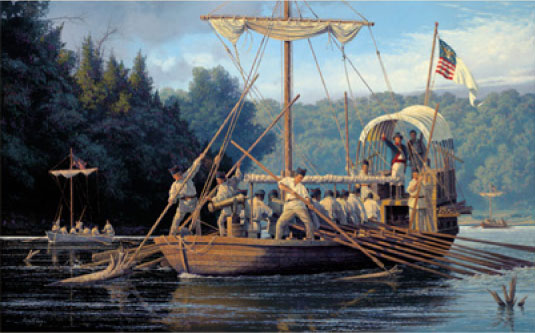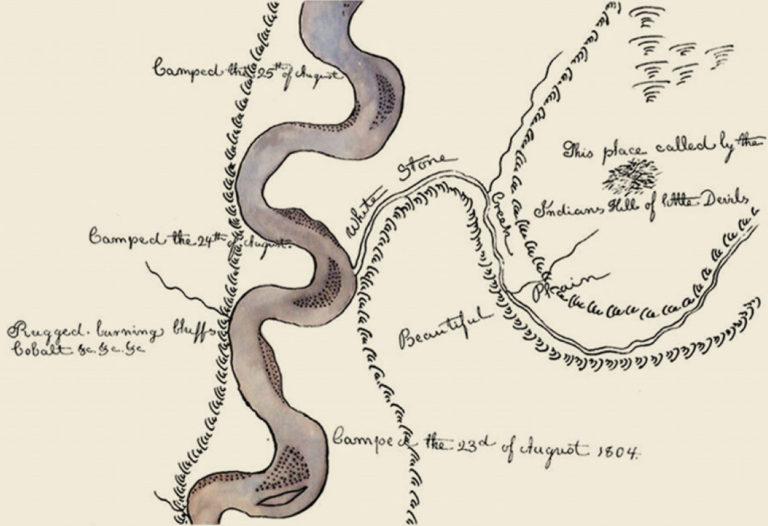The Story of Spirit Mound
Legend
THe Legend of SPirit Mound
Long before white men came to what is now South Dakota, the little hill known by the Sioux as Paha Wakan was held in awe by tribes for miles around. The Omaha, the Sioux, and the Otoes believe that the mound was occupied by spirits that killed any human who came near.
By the 1790s, when white traders came up the Missouri as far as the Vermillion River, reports of these "little spirits" must have been well known. Although no written record earlier than the journals of Lewis and Clark has been found. On August 24, 1804, the day before they reached the mouth of the Vermillion, which they called the White Stone River, Clark wrote:
"Capt Lewis and my Self Concluded to visit a High Hill Situated in an emence Plain three Leagues N. 20° W. from the mouth of White Stone river, this hill appear to be of a Conic form and by all the different Nations in this quater is Supposed to be a place of Deavels or that they are in human form with remarkable large heads and about 18 inches high; that they are very watchfull and ar armed with Sharp arrows with which they can kill at a great distance; they are said to kill all persons who are so hardy as to attemp to approach the hill; they state the tradition informs them than many indians have suffered by these little people and among others that three Mahas Souix Ottoes and other neibghouring nations believe this fable that no consideration is suffiecient to induce them to approach this hill."
Expedition
The Lewis and Clark Expedtion
To find out about western land acquired in 1803 by the Louisiana Purchase, President Thomas Jefferson selected his personal secretary, Captain Meriwether Lewis, to lead an expedition into the unknown territory. Congress appropriated $2,500 for the exploration.
Beginning in 1804, Lewis and his friend Captain William Clark led a "Corps of Discovery" up the Missouri River, over the Rocky Mountains, and to the Pacific Ocean and back. Returning to St. Louis in 1806. They made detailed maps, took scrupulous notes on the wildlife, landmarks they saw, and in journals filled with vivid prose (though with indifferent spelling) recorded and interpreted their experiences along the way.
The Lewis and Clark expedition, which opened the way for settlement of the western half of the nation, is a momentous event in United States history. The hill now known as Spirit Mound is the most significant Lewis and Clark site in South Dakota. Historians recognize the mound as one of few remaining sites where we know with certainty that Lewis and Clark actually stood.

Captains Lewis and Clark
Where two Captains once stood
On August 25, 1804, a hot, humid Saturday, Captains Lewis and Clark took eleven other men and Lewis’ dog Seaman and crossed the Missouri from their camp on the south side, while the rest of the expedition proceeded on up the river. They left two men to guard their canoe and walked nine miles to the Mound. Their journals describe the day in vivid, enthusiastic detail.
It was a hard trip, and Seaman, suffering from the heat, had to be sent back to the Vermillion River. Despite the rumors of danger, the men approached the hill and climbed to the summit, which they determined to be about 70 feet above the surrounding plain and to be of natural origin, not man-made. They also noted the abundance of insects near the top, which attracted great flocks of swallows "so gentle that they did not quit the place until we arrived within a few feet of them," and the Captains speculated that it was the birds that gave the mound its air of mystery.
The men were deeply impressed by the view from Spirit Mound. Clark wrote:
"from the top of this Mound we beheld a most butifull landscape; Numerous herds of buffalow were Seen feeding in various directions, the Plain to the N. W & N E extends without interuption as far as Can be Seen- ... no woods except on the Missouri Points...if all the timber which is on the Stone Creek [Vermillion River] was on 100 a[c]res it would not be thickly timbered, the Soil of those Plains are delightfull."
This was the first time that the Captains had been miles away from the river valley and viewed from a high point the tallgrass prairie that they had been sent to explore. It was also the first time that they had seen buffalo herds. Besides the buffalo and elk "upwards of 800 in number," they found burrows of either badgers or "prairie wolves" (coyotes), and saw meadowlarks, swallows, blackbirds, wrens, an American Bittern, and the first bat they had seen on the expedition.
They also marveled at the abundance of wild fruit: "here we got Great quantities of the best largeset grapes I ever tasted, some Blue currents stil on the bushes, and two kinds of plumbs, one the Common wild Plumb the other a large Yellow Plumb...about double the Size of the Common and Deliscously flavoured...."
Suffering from heat and thirst, when they left the mound they detoured to the northeast three miles to the closest point of the Vermillion River. After resting there for about an hour and a half they followed the valley back to the Missouri and resumed their voyage the next day.
Excerpts
From the Journal of WIlliam Clark
August 25th, 1804
"...dropped down to the mouth of White Stone River where we left the Perogue with two men and at 200 yards we assended a riseing ground of about Sixty feet, from the top of this High land the Countrey is leavel & open as far as Can be Seen, except Some few rises at a Great Distance, and the Mound which the Indians Call Mountain of little people or Spirits"
"...we left the river at 8 oClock, at 4 miles we Crossed the Creek 23 yards wide in an extensive Valley"
"...at 12 oClock we arrived at the hill...heat...&...thirst...deturmined us to make for the first water which was the Creek in a bend N.E. from the mound about 3 miles"
"...w[e] Set out on our return down the Creek thro: the bottom of about 1 mile in width, Crossed the Creek 3 times to the place we first Struck it where we geathered Some delisious froot Such as Grapes Plumbs, & Blue Currents"
"...we Set out on our back trail & arrived at the perogue at Sun Set we proceed on to the place w[e] campd. Last night and Stayed all night..."
Expedition
By: Kent Scribner
Click here to read an article by Kent Scribner that intends to survey the events that occurred after Lewis and Clark visited the mound in 1806.
